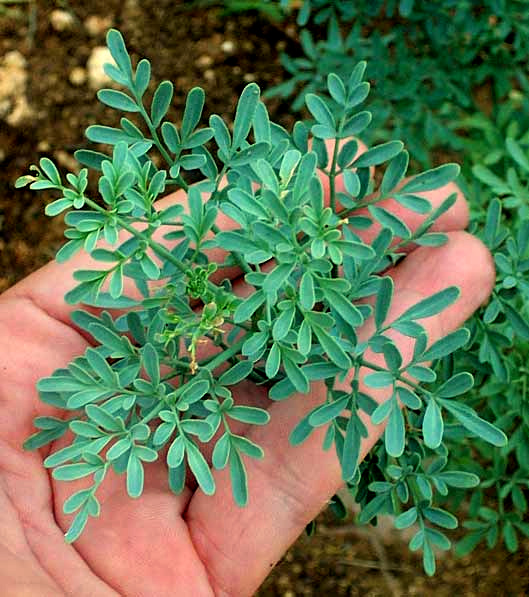Excerpts from Jim Conrad's
Naturalist Newsletter
from the May 12, 2007 Newsletter issued from Sierra Gorda Biosphere Reserve, QUERÉTARO, MÉXICO
THE RUE IN DON GONZALO'S EAR
The other day Don Gonzalo's helper, Silvestre, was watering plants as I walked by. Smiling broadly he stopped me, plucked a sprig from a tender-looking, bluish green herb being watered, rolled up the sprig (a penetrating medicinal odor suffused the air during the demonstration), stuffed it into his ear, and told me that this is how people around here cure earaches.
You can see the earache herb below:

Don Gonzalo and Silvestre call the plant Ruda. In English it's Rue, and in Latin RUTA GRAVEOLENS. It's a member of the Citrus Family, the Rutaceae. Originally it's from southern Europe but it's planted in gardens worldwide, and often escapes or persists.
When I was gathering information for the Medicinal Plants page of my Traditional Mexican Markets Website, at http://www.mexicanmercados.com/produce/mediherb.htm I found that Rue is one of the most powerful plants in the traditional Mexican pharmacopoeia. The first thing I learned about it was that it is used to induce menstruation and to abort unwanted fetuses.
I also learned early that the tender-looking little plant is so powerful that it's dangerous. A warning at http://www.floridata.com/ref/R/ruta_gra.cfm reads:
That site also informs us that the Rue leaf was the model for the Suit of Clubs in playing cards.
Why would the Rue leaf be honored with such a position on playing cards? Surely it's because in earlier times Rue was so recognized as powerful medicine that it also acquired renown for its magical properties. It was used as a defense against witches. Michelangelo and Leonardo da Vinci are said to have eaten rue to enhance their creativity and eyesight. Rue symbolized regret, sorrow and repentance, and Catholics put sprigs of it in holy water sprinkled on worshippers. At http://www.botanical.com/botanical/mgmh/r/rue---20.html you can read Mrs. M. Grieve's extensive review of its traditional uses, as of about a hundred years ago.
Is Rue really an effective medicinal herb? Don Gonzalo says it makes a good-tasting tea with no side-effects, so one wonders.
But, at http://www.herbmed.org/Herbs/Herb63.htm we read that "Treatment of 15 patients with intracranial tumors, using Ruta 6 from Ruta graveolens and Ca3(PO4)2 showed that 6 of the 7 glioma patients had complete regression of tumors and thus in combination they are used in brain cancers, particularly glioma."
Googling the keywords "'ruta graveolens' medicinal" I get 101,000 returns.
Whatever the case, I'm glad Rue is growing near my casita, just in case I ever get an earache.